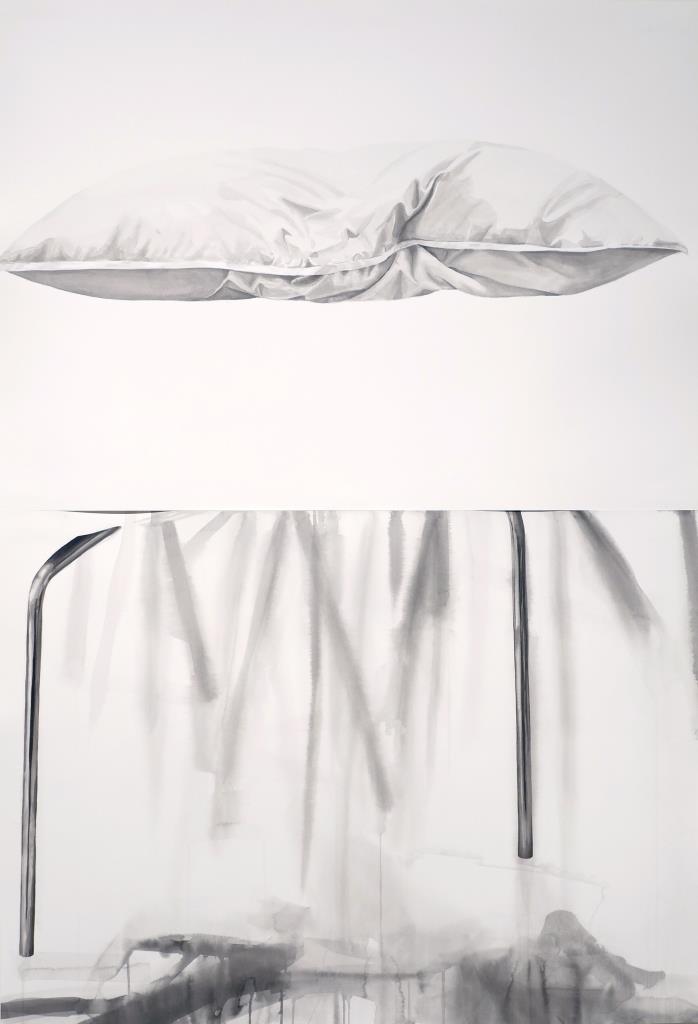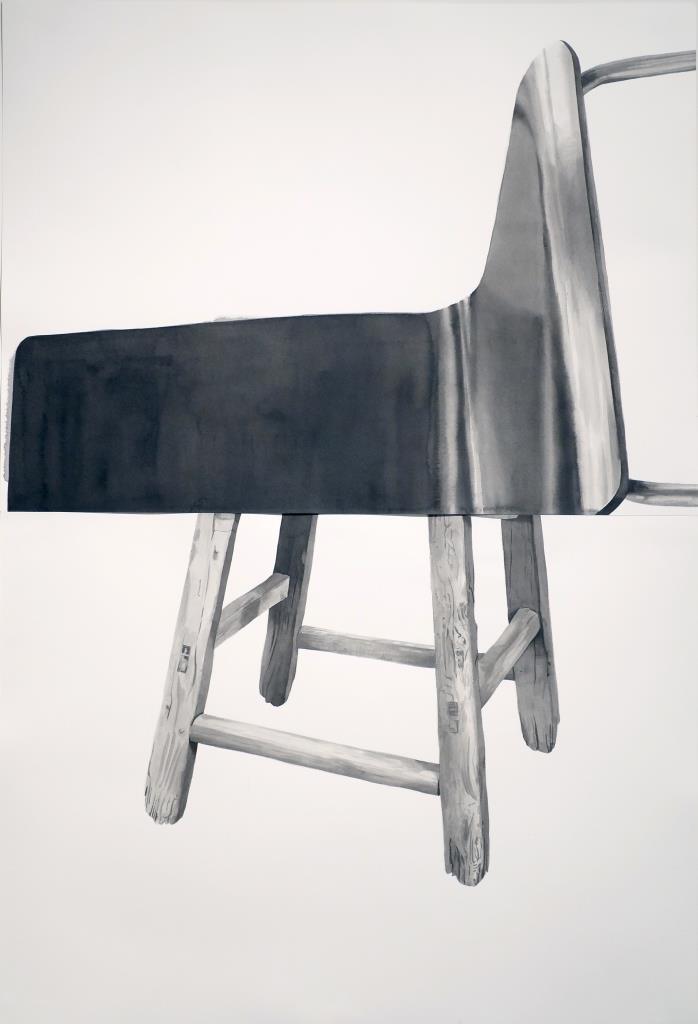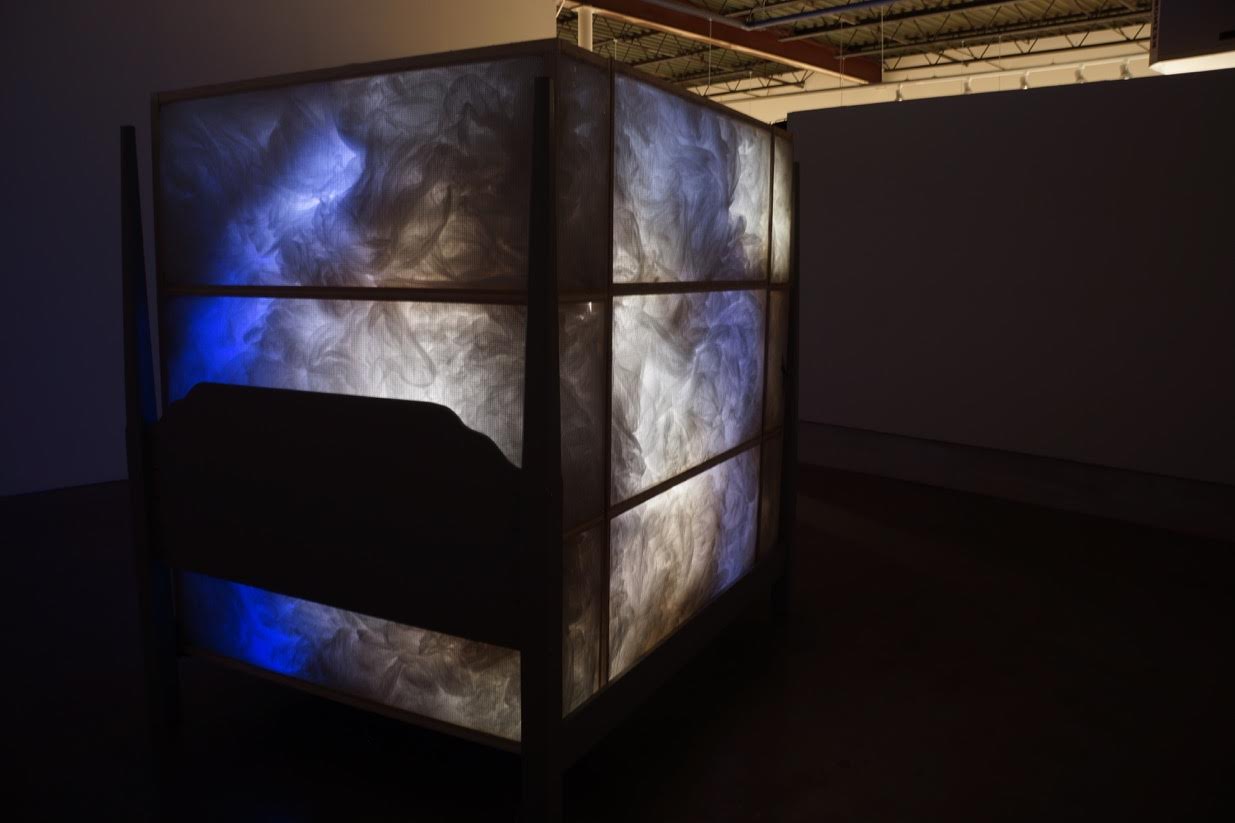Home and the Unseen World
New work by Shana Kaplow and Rebecca Krinke explores the usually unremarked global, personal, political stories tangled just beneath the glossy veneer of the mass-market objects that furnish our lives

I step into Rosalux Gallery and wish I could take a seat in the world of Shana Kaplow’s ink on paper painting, Traveler. It’s an elegant representation of the basic plastic lawn chair found on so many porches and backyard patios, yet her otherwise realistic rendering of this almost-disposable piece of furniture abruptly dissolves into rows of billowing smoke. In the top register, translucent ink swashes bleed into the pores of the paper, as if the plastic material were melted and then evaporated into a blank expanse. With no back for support and the chair’s arms dismembered, what appears at first glance to be a near photographic replica of a lawn chair morphs into something more uncanny.
In Rosalux Gallery’s August exhibition, Low Lying Area, local artists Shana Kaplow and Rebecca Krinke reimagine such simple pieces of furniture through painting, sculpture, and installation to unearth the connections between the personal and collective embedded in the familiar physical world. In Kaplow’s series of nine ink-on-paper paintings, she selects a plastic lawn chair, a mushroom-shaped stool, a basic black table, and a cotton pillow for her subjects. These common objects become far less so when translated to ink this way, granted a preternatural nobility by virtue of a rare attention and care given to the detailed execution. Kaplow’s rigorous line work and expert ink washes elevate each object, imbue it with an aura of importance exceeding its industrial, mass-produced origins.
Many of Kaplow’s artworks feature diptychs with one image floating on top of another that make for a landscape filled with both cohesion and disillusion. While many image pairings seem to mirror one another, other times they illuminate a stark contrast—between the modern and traditional, expensive and cheap, substantive and ephemeral. For instance, in Expansion of Wealth, a sleek IKEA chair lies lopsided on top of a worn Chinese worker’s stool. Reminiscent of similar re-makings of stools at Kaplow’s recent exhibition at the Minneapolis Institute of Art, this stool likewise carries a map of splintered cracks, a testament to years of use. In contrast, the unblemished manufactured materials of the chair above that worn stool references those for sale in the aisles of IKEA. Chairs, some of the most universal objects in the world, seen in this light bear markers of class, status, and culture. The drastic rupture between the overlaid paintings allows for a deeper investigation of the narratives they each carry; in a real sense, the worn stool of a worker supports the production of this attractive and profitable First-World chair.

Kaplow began the project by photographing furniture displays in department stores. The resulting paintings of these consumer items peel back the façade of luxury and marketability with which they’re presented in the store. In doing so, Kaplow reveals a darker side to their making. In Above and Below, an ink on paper painting of a simple pillow, also off the shelf from IKEA, floats in the middle of the page. Suggestive remnants of human touch can be found in the center of the pillow: the fabric makes sweet folds inward, leaving behind a cast of an absent head. The impressionable, delicate material is a departure from the cold textures that abound in the surrounding paintings. The pillow, a vital part of both sleep and comfort, invites rest, a state of pleasurable complacency. Yet directly below that soft pillow, pointed spikes of sleek metal furniture legs poke through in a jigsaw of haphazard shadows. They interrupt the overlaid dream to ask, what is my comfort, and what is built from? More pointedly, she asks: “When we put our heads down at night, what is it balanced on?” For Kaplow, the personal is political and, as a seasoned artist, that intersection is integral to her practice. The objects Kaplow reconsiders here are often fabricated far away and later circulated in a market that hides the violent and destructive stories behind their making. With this disconnect ever-present, Low Lying Area crawls into the intimate spaces of our homes to unmask the layered narratives where industry and domestic intimacy collide.

Wandering through a black dividing curtain between the two gallery rooms, I’m transported into Rebecca Krinke’s Dream World II, the fourth part of a sculptural bed series. As a multi-disciplinary artist, Krinke uses sculpture, installation, and participatory art to access the secret world of dreams and psychological unknowns. An imposing four-poster bed is positioned in the middle of a dimmed, silent room. On each side of the bed, Krinke has engineered four wooden boxes lined with thin, wire cages to create an enclosed space. White, translucent material and fluorescent lights fill the constructed boxes to illuminate the sculpture from within. The result is a mystifying glow box of nightmarish possibility. Each side generates a sculptural swirl of electric blues and smoke-filled greys, as if a drop of ink has been left to dissipate in a hazy pool of white liquid. Landscapes of ominous clouds carry the silhouettes of jet black feathers and wisps of straw float in the confines of the walls. Krinke describes how Dream World II denies the viewer access to the mattress. No longer a site of simple comfort, it becomes “a mysterious enclosed volume” beckoning viewers to dream about what may be inside.


At Rosalux, Krinke composed a space for people to dream collectively at once—an experience, she notes, that differs from the private ritual of sleeping or dreaming in a bedroom. Her installations here use the same four-poster bed, straw, and feathers found in a former bed sculpture, Incident (2014), but also bring in the prophetic dreams collected during a participatory art project known as “dream collecting” during Northern Spark earlier this summer. In the Mill City Ruin Courtyard, nuit blanche participants described their dreams through words and pictures on ethereal Mylar squares of paper. After collecting over 500 such dreams, the artist and her team sewed them together to create a quilt called, What is the City Dreaming? displayed now in the entrance to the Rosalux gallery. The array of dreams is diverse, sometimes absurd: a ferocious whirlpool swallowing a snake, an octopus with a human head wearing an eye patch, a toaster catapulting bread into the air. Not all of the dreams had a whimsical feel. Krinke shares how some dreams “raised a shiver along my spine”: recurring themes of flooding, flying, or even descriptions of furnishing eerily similar to those found in her sculptures. Just as participants in Northern Spark freely shared their dreams, Dream Window II invites the remnants of a viewer’s own dreams to nestle within its hidden room, a space of collective imagination for all who enter.
Low Lying Area brings the privacy of the home into a public sphere and demonstrates how everyday physical things carry traces of both personal story and collective memory. As Kaplow asked me: “What are we choosing not to see? What would it look like to reveal the background aura of these objects?” Both artists entice viewers to move beyond surface level understandings of the common objects all around us, and ask us to delve into the encoded stories that lie beneath—to do with culture, imagination, and humanity. Perhaps, this work seems to suggest, the search for self and belonging can begin in the low lying area of home.
Related exhibition details: Low Lying Area, featuring new work from Shana Kaplow and Rebecca Krinke, is on view in Rosalux Gallery, Minneapolis through August 30, 2015.